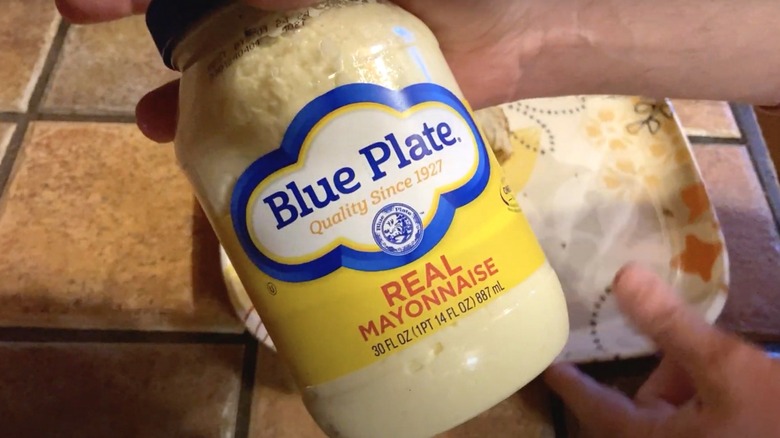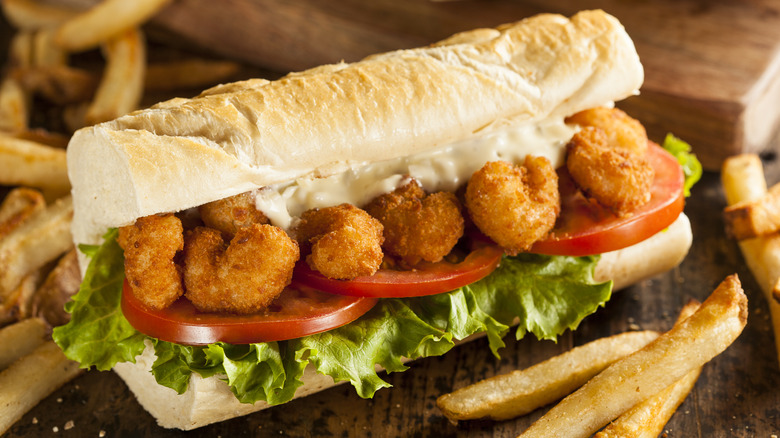What's So Special About Blue Plate Mayonnaise?
People go hard for their mayonnaise brand of choice, whether that's Hellman's, Duke's, or Kewpie — but what about Blue Plate mayo? If you're not from the South, you might not even know of this brand, but fans of the product swear it's the best on the market. They love the short ingredient list, and say it has a richer taste and texture compared to other brands.
While preferences can often be based on habit, nostalgia, and brand loyalty, the straightforward ingredients in Blue Plate mayonnaise do set it apart. It's made up of soybean oil, vinegar, egg yolks, water, salt, and sugar, with the preservative calcium disodium and unspecified natural flavors rounding out the list. To put that in perspective, Kraft mayo, for example, has water listed as its second most plentiful ingredient, and contains around five more ingredients than Blue Plate.
Blue Plate fans say the mayo has a creamy flavor and texture, with just the right amount of tanginess. The use of only egg yolks makes it taste more homemade compared to other store-bought mayos, and the bright acidity provides lift and balance when paired with other acidic foods.
Blue Plate mayo is a Gulf Coast staple
Blue Plate mayo was founded in 1927 in Gretna, Louisiana, just south of New Orleans. Blue Plate mayo was an important product, as it was one of the first commercially produced mayonnaises in the United States. This significantly changed the culinary landscape. Previously, mayo was made in limited quantities, and considered a luxury product. Blue Plate helped mayo become more accessible; now, it's commonly used in New Orleans dishes like shrimp remoulade and roast beef debris po'boys.
Blue Plate is a staple in Louisiana and the surrounding Gulf Coast states, and is now produced in Tennessee. Unfortunately, it is not typically available in stores outside the region. However, it is available online, and many go out of their way to keep their shelves stocked.
For a more accessible alternative, Duke's mayo — which happens to be Alton Brown's favorite mayonnaise — is another widely lauded southern condiment, hailing from Greenville, South Carolina. While it is rich and creamy, thanks to extra egg yolks along with whole eggs, it does not contain any sugar. Folks also describe this brand as tasting homemade, but it definitely has a sharper acidity than Blue Plate. Opt for Duke's if you crave discernible sharpness, and Blue Plate if you want a more balanced, eggy flavor.
How to use Blue Plate mayo
Sample the typical taste of Blue Plate mayonnaise in traditional dishes from the area, such as spicy and savory remoulade, po'boys filled with fried fish, shrimp, or crawfish, potato salad, deviled eggs, creamy seafood salads, crab dip, and dipping sauces. The combination of sweetness and pleasing tang in Blue Plate mayonnaise also makes it especially well-suited for pairing with vegetables, as in creamy cucumber and broccoli salads.
An excellent dish to make so you can fully appreciate the deliciousness of Blue Plate — or to compare different brands of mayonnaise to find your favorite — is a classic southern-style tomato sandwich. This sandwich is deceptively simple, but the three main ingredients come together in perfect harmony. It requires nothing more than bread, tomatoes, and mayo.
Use squishy, untoasted white bread, thick slices of juicy, ripe tomatoes, and lots of creamy mayonnaise on both sides. Season simply with salt and freshly cracked black pepper, and revel in the alchemy. The acidity and sweetness in the mayo bring out the same notes in the tomatoes, and the bread is there to soak up the combined juices. If that strikes you as too simple, Blue Plate mayo also makes an excellent BLT, or a crispy chicken skin, lettuce, and tomato sandwich.



